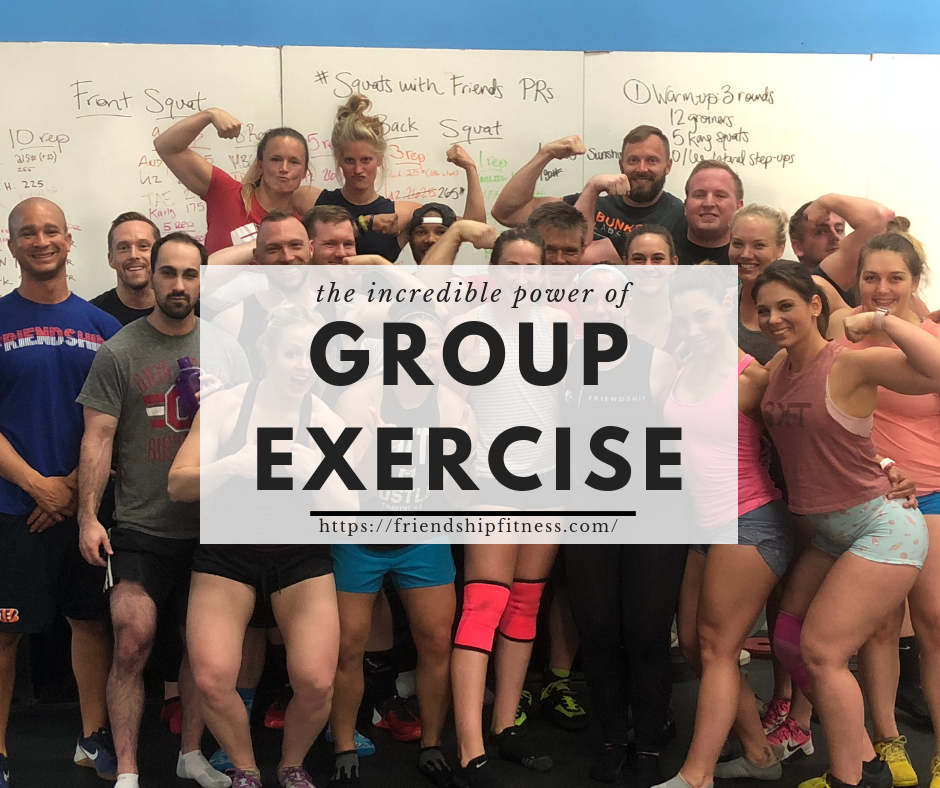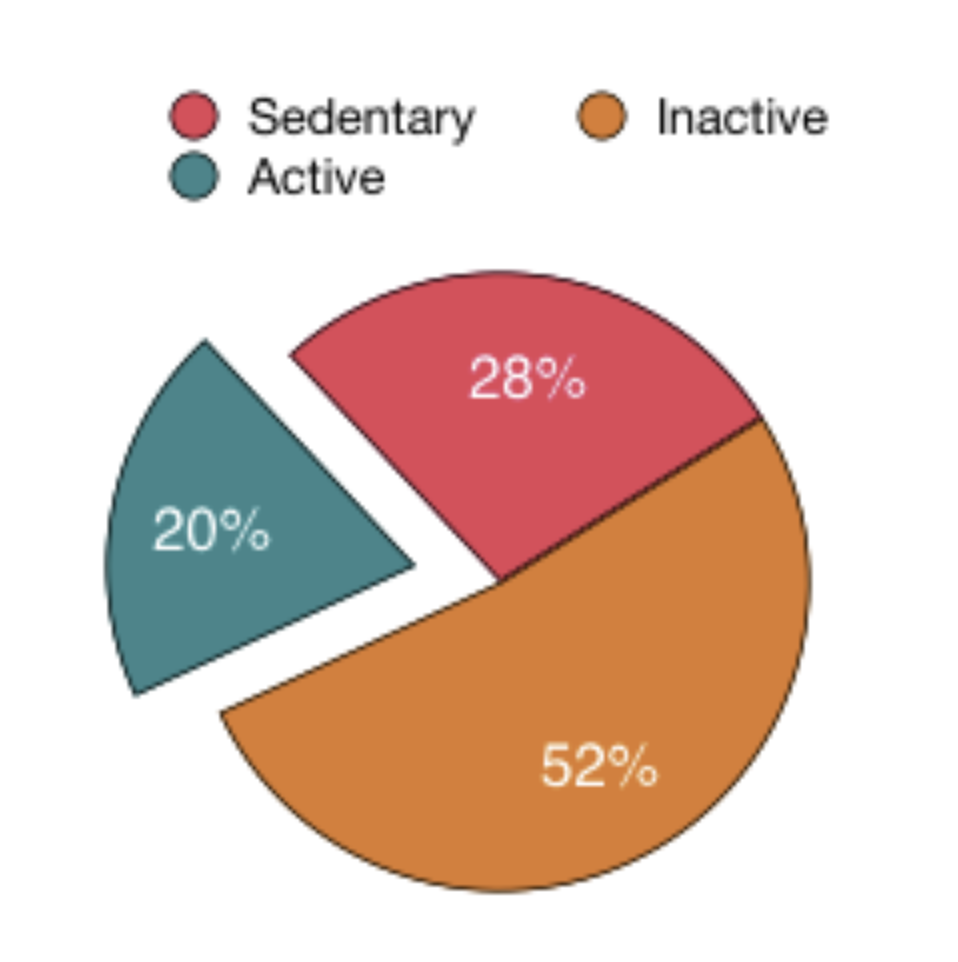The Power of Group Exercise
This image shows the difference between active, sedentary and inactive people for group exercise
There’s a reason why micro gyms and CrossFit communities are popping up in every neighborhood. Group fitness is the most potent form of exercise. But before we get to the “why” of this article, let’s hit pause and check America’s pulse.Bare minimum, The American Heart Association recommends that adults get at least 150 minutes of moderately intense aerobic activity or 75 minutes of vigorous aerobic activity per week in addition to strength training.According to the U.S. Department of Health & Human Services:
Only about 20% of Americans get the recommended physical activity per week.
80% do not exercise or get the recommended physical activity per week.
28% are not physically active at all and live a sedentary lifestyle.
If these numbers don’t have your jaw on the floor, they should. The implications of an inactive or sedentary lifestyle are numerous, far-reaching, and life-threatening.
Cancer
Heart Disease
Arthritis
Lower Back Pain
Depression
Anxiety
Alzheimer’s Disease
Early death
Obviously, the solution is to start moving your body. The problem, however, is sticking to a fitness routine.
The Power of Group Exercise
There is no shortage of research supporting the theory that group exercise is more effective than individual training. However, it was a study released in 2017 by the Journal of the American Osteopathic Associationthat revealed just how powerful group exercise can be. The study compared the physiological and psychological conditions of people who participate in group exercise versus independent exercise, and resulted in two key findings:
Those who participated in group exercise had a 26% reduction in stress and “significantly improved” their quality of life.
Those who exercised independently exerted more effort but experienced no significant changes in stress levels, and a limited improvement to their quality of life.
This study validates what experts have been expressly telling us all along. Total health is mental, physical, and emotional. Which brings us to the core of today’s topic. Why is group exercise the reigning champion of physical activity? Because it positively impacts all three states of being.
1. Improved Mental Health
Group exercise decreases your frequency of “poor mental health” days.
Lancet Psychiatry studied the association between physical activity and mental health in 1.2 million Americans. They discovered that people who participate in group exercise reduced their monthly frequency of poor mental health by more than 20%.
To better understand why group exercise has a higher impact on mental health than independent exercise (which still has an effect, but not as high) the fine folks at Oxford’s Institute of Cognitive and Evolutionary Anthropologystudied how the human brain responds to group activity. When they specifically looked at brain activity in those who exercise in a group, they found that the brain released a flood of chemicals that trigger “the same responses that have made collective activities from dancing and laughter to religion itself such enduring aspects of human culture.” This chemical reaction (often referred to as “runners high”) creates a feeling of well-being and even blocks one's perception of pain. Researchers link this reaction to the evolutionary benefits of group bonding. In yet another study published in the Journal of Trauma and Treatment, group exercise also resulted in “significant reductions in PTSD, anxiety, and depression.
2. Increased Motivation & Accountability
Those who participate in group exercise are significantly more likely to reach and maintain their health goals.
When exercise is scheduled at a specific time and place, it’s more difficult to push aside. Add a little social competition and encouragement to the mix, and you’re far less likely to bail. In a study reported on by NBC News, 95% of people who start a weight-loss program with friends complete the program (almost 20% higher than individual exercise). These individuals are also 42% more likely to maintain their results (source).
In a Nielsen Survey involving 3,000 participants of group fitness classes worldwide:
85% of individuals who participate in group exercise visit their facility 2x per week.
43% of individuals who participate in group exercise visit their facility 4x per week.
3. Enhanced Social Life
Hey, fellas — did you know that women make up 52% of fitness clubs and at least 62% of group fitness participants?That’s a promising ratio!
Group fitness classes are excellent places to meet new friends, network with local business owners, and perhaps even meet your soul mate.
Fun Fact: Friendship Fitness is the meeting ground for 13 gym weddings!
The brainiacs at Stanford Medicine reported on a study about the correlation between connectedness and health. They found that social interaction contributes to:
50% increase in lifespan
Higher self-esteem and empathy
Better emotional regulation skills
Lower rates of anxiety and depression
4. Improve Physical Form
Repetitive motion injuries are one of the most common injuries in the United States and represent over 50% of all athletic-related injuries (source).
Repetitive exercise can put too much strain on certain tendons, joints, and muscle groups while completely neglecting others. These overworked areas can experience microscopic tears in the tissue that never get a chance to heal. As a result, individuals develop tendonitis, arthritis, rotator cuff pain, bursitis, and other injuries that can become chronic and require months to heal. Furthermore, your body is smarter than you think! If you perform the same exercise routine long enough, your muscles adjust to the activity and strength building will plateau.
Group classes diversify workouts to build balanced strength in all muscle groups and maximize the time and energy you spend at the gym. Participants are essentially taking an instructional course on physical movement and even learn ways to modify movements to prevent injuries. When a certified and experienced instructor is at the helm, participants also receive immediate feedback from an expert on form and execution, which reduces their risk of injuries and encourages them to keep working toward a goal.
5. Increase Your Gains
Those who exercise with a more capable partner increase their performance by 24%, and intensity and workout time by 200% (NBC News).
The positive social reinforcement of group exercise pushes you to go beyond your perceived physical limitations, but in a safe environment under the watchful eyes of a certified instructor (if you select the right gym). In a study commissioned by Virgin Active, 64% of women push themselves harder in a group workout than if they exercise alone (source).
The Friendship Difference
The science behind group exercise is indisputable. If you are ready to make 2019 the year you finally reach your health and fitness goals, join us at Friendship Fitness. We are one of the most unique and diverse fitness communities in Columbus, Ohio. No matter your age or fitness level - all are welcome here. Check us out online, schedule a free consultation, or stop in and see for yourself. We can’t wait to meet you!
If you enjoyed reading this article, don’t miss Part Two, coming soon!
In the next edition, we’re going to show you how our fitness community amplifies the positive effects of group exercise using music, gamification, education, and camaraderie to help individuals exceed even their most ambitious health goals.
Has group exercise ever positively impacted your health and fitness journey? We want to hear about it! Comment below and tell us what you liked!


